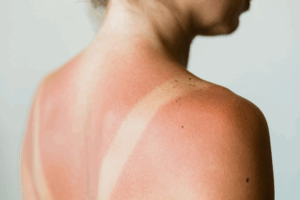Read Full Article HereWe Asked Healthcare Professionals And Patients About The Common Yet Dangerous Skincare Condition As Part Of Psoriasis Awareness Month.
Psoriasis is a common skin disease without a cure, affecting 125 million worldwide and more than eight million in the United States according to the National Psoriasis Foundation. The National Institutes of Health defines psoriasis as a chronic illness “in which the immune system becomes overactive, causing skin cells to multiply too quickly.” Symptoms of psoriasis include skin rashes, flaking, stiffness, and peeling, and it’s often confused with other common skin conditions, such as eczema, as psoriasis is frequently diagnosed visually. Doctors examine the affected area and can recommend a biopsy to determine what the patient is dealing with.
Though people don’t often immediately think of psoriasis when they think of skin conditions that affect Black women, it can impact not only Black women’s ability to be comfortable in their skin, but their self-esteem as well. We spoke to healthcare professionals and Black women living with the disease as the spotlight is on the condition for Psoriasis Awareness Month.
How It Shows Up on Black Skin
Twenty-nine dermatologists considered to be leaders in the study of psoriasis were surveyed about how symptoms manifest in Black patients by the Journal of Drugs and Dermatology. Sixty-six percent said they witnessed “different manifestations of disease, such as more dyspigmentation, thicker plaques, and less erythema in African Americans.
Adrianna Gonzalez, MD confirms this. “I do definitely see differences from my Black patients and non-Black patients,” she tells ESSENCE. “One of the major things is the color. The classic psoriasis findings that you think of is this pink red, very scaly plaque, and in patients of color, it is very rarely like that. It also leaves behind a lot more discoloration.”
According to the American Academy of Dermatology Association, “In African Americans, the psoriasis often looks violet and the scale gray. In dark skin, the psoriasis can also be dark brown and difficult to see.”
“Dermatology is a very visual field, and in our training, we look at subtle differences to make diagnoses,” Miranda Ewelukwa, MD of U.S. Dermatology Partners says. “Sometimes color is very important. It’s really important to know those nuances.”
Psoriasis Or Dandruff?
“I’ve noticed that in my skin of color patients, they are a lot more likely to have scalp psoriasis and sometimes that’s the only presenting sign,” says Gonzalez.
Ashley Farrow, a nurse, experienced symptoms in her scalp prior to her diagnosis. “I’ve always been told that I had really bad dandruff,” she says. A hairstylist prompted her to seek medical attention. “I don’t think you have a dandruff issue,” Farrow recalled the stylist telling her. “I think this is psoriasis.”
Gonzalez says that psoriasis is commonly mistaken for dandruff. “It’s very unfortunate because it tends to be, in my experience, even more severe,” she notes.
Farrow saw a dermatologist who confirmed the diagnosis but did not consider specific needs connected to her having melanated skin when prescribing treatment. “My dermatologist that I went to was white, and she gave me medication that was basically alcohol-based. So it really kind of helped, but it also for my type of hair, dried it out. It was not really working for me,” she explains.
The experience was so harrowing for Farrow that she is considering switching to a new specialty professionally in order to create change — dermatology.
The Impact on Self-Esteem
According to a 2020 study published in Advances in Dermatology and Allergology, “psoriasis patients are not infrequently classified as different or stigmatized.” Deidre Morgan, a licensed clinical social worker, had her self-esteem impacted by her symptoms as a young Black woman in her 20s. She sought help after noticing changes in her forehead and nose area.
Morgan found a way to manage her symptoms by changing her diet. In 2020, the International Journal of Molecular Science found that “nutrition influences the development and progress of psoriasis and its comorbidities.”
“I figured out after I did my own research that sugar and dairy tends to make psoriasis flare up,” she says. “So I completely changed my diet.”
Beauty Regimen Gone Bad
Patients with psoriasis should think twice before rushing to pick up the latest recommendation from #fragrancetok.
“When you think about skincare products, you want to avoid common irritants, and fragrance is one of the most common irritants, as well as sulfates and phthalates,” says Dr. Jen, a Cosmetic Scientist and Skin Expert familiar with the formulations that can trigger psoriasis.
She advocates for minimizing alcohol and dairy, “which is a known inflammatory.”
Visible Symptoms Are Not the Only Risks
Risks for associated illness accompany a psoriasis diagnosis. Ewelukwa explains how obtaining an accurate diagnosis can improve patient outcomes.
“If it’s caught at an early stage, it’s definitely much, much better for the patient,” she says. “Psoriasis is a chronic condition. So, over time, it’s worse, and patients can develop new skin lesions and difficulty through areas, and there’s an associated diagnosis, psoriatic arthritis, that we all watch out for.”
“Psoriatic arthritis is not the only associated disease,” she adds. “A lot of psoriasis patients have something we call metabolic syndrome. Metabolic syndrome is a constellation of symptoms that can be associated with diabetes, heart disease, and liver disease. So it’s really important that we act on that and catch the diagnosis early so we can treat them early so they don’t have long-term bad outcomes.”
Neither Farrow nor Morgan were informed about the risk for associated illnesses by the doctors who diagnosed their conditions.
“They did not give me any of that information,” Morgan says. “I was just sent home with a pamphlet.”
What Is Missing From Psoriasis Research
“The training in dermatology is still very archaic,” says Gonzalez. Ewelukwa agrees, saying training materials that are not inclusive can present problems.
“If you’re trained where you’re only reading certain texts, you’re definitely going to have a gap when it comes to being able to make the correct note diagnosis in someone who has more melanin, pigment in their skin,” she says.
Attempts have been made to improve the representation in resources available to medical students and doctors. Medical student Malone Mukwende co-authored a booklet designed to help illustrate what skincare conditions look like on patients with darker complexions. These efforts are helpful, but Dr. Jen says there still isn’t enough information known about the disease.
“And it’s definitely not enough information known with Black skin,” she adds. “We really need to understand what that looks like.”
Everything You Need To Know About How Psoriasis Shows Up On And Affects Black Skin
August 24, 2023








